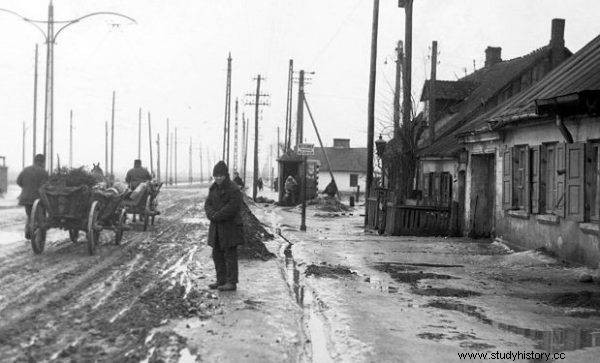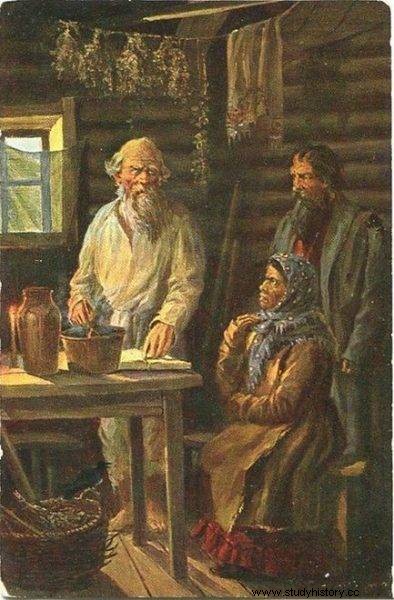Work from dawn to dusk. Poverty, helplessness and black ingratitude. And on top of that, clients who, instead of specialists, call out babes and quacks. What can I say:you wouldn't want to be a doctor in a pre-war village!
For a doctor, working in the countryside or in a small town was usually a last resort. The village physician did not have access to specialist equipment that was at the disposal of municipal hospitals and clinics. The lack of adequate facilities limited the possibility of making an accurate diagnosis and performing a surgical procedure. Rural doctors often bought basic laboratory equipment (e.g. a microscope) with their own money. It was an expense of about a thousand zlotys, while for a private visit the patient paid about 4-5 zlotys, if he had any money at all. As Remigiusz Piotrowski writes in the book "Absurdy and curiosity in pre-war Poland":
In case of illness, wealthier inhabitants decide to go to the nearest town, the poor usually visit a doctor only when the patient's health condition is very bad. The latter usually do not have a penny to pay for the visit and offer the doctor remuneration in the form of eggs, butter or milk.
The villagers, who had no insurance, were not entitled to free medical visits. So it happened, especially in the case of the youngest patients, that the doctor collected 5 zlotys for the examination, and he spent 20 from his own pocket to buy serum for a child suffering from diphtheria. Without it, the sick person could suffocate.
Many similar cases were described in the "Diaries of Doctors", a collective work based on reports sent to the competition for health care workers. The competition was organized in 1936 by the Social Insurance Institution, and the preface to the anthology was written by Melchior Wańkowicz. A famous reporter and writer called the rural people, almost entirely deprived of proper medical care, the ocean of human misfortune .
I won't let the child go to the hospital, he'd better die at home
Postponing a medical visit to the last minute often resulted in the disease being so advanced that the patient required hospitalization. Meanwhile, many people believed that you go to the hospital only to die, so it is better to live at home, surrounded by loved ones. Considering what customs and conditions prevailed in some pre-war medical centers, it is possible to understand the fear of potential patients. Remigiusz Piotrowski describes the situation in Czeladź in the already cited book:
the management of a local hospital comes up with a brilliant idea in the late 1930s. From now on, as reported by hospital decision-makers, visits for patients will be paid .
Hospital visits cost 50 groszy, a small amount, but rural families also had to pay the cost of a trip to the city.
There were many more superstitions. For example, it has been argued that an injection can kill. The fatalists said - sand will pull everything out . A far more difficult task for the doctor than treating a serious illness was to persuade the patient to wish to undergo therapy at all. In "Diaries of the Doctors" there is a case where the father explained to a doctor that he was summoned to a boy suffering from pneumonia that an injection would not hurt a healthy one, but that it could kill a sick person because it would weaken him too much. Drugs that could be taken orally and at home care were trusted.
Doctor, cow and itchy back specialist
According to the "Little Statistical Yearbook of 1939", just before the war, Poland had 12,917 doctors. Apparently a lot, but only 1466 of them worked in the countryside, where… 2/3 of the population lived! Since doctors in rural areas were 'like a cure', many sick people had to travel a long way to seek medical advice. The patient who came to the doctor's office after three hours of walking had high expectations.
Doctor Karasiówna in "Diaries of doctors" mentions a woman from a remote village with whom she found herself pregnant. After the examination, the patient demanded that the doctor extract another tooth from her, prescribe powders for her husband for a headache, and gave the children something for cough and diarrhea. The caring hostess did not fail to ask for medicine for the cow. A specialist in a white coat might have reckoned with being asked to write down something for bedbugs.

In the countryside, doctors were often asked not only for medicines for people ... they were also required to treat cows and fight bedbugs ...
Despite the general distrust of health care, there were also hypochondriacs in the villages who sentenced the doctor to search for imaginary diseases for a long time. They usually assumed that if they pay a contribution to the Health Insurance Fund, they simply deserved medical care. So they were able to come to the doctor only because their backs were itchy. There were times when a person living near a doctor's office wanted to be checked every day.
Space-magnetic-electric therapies
In general, rural people were more likely to visit a healer, a possessor of secret knowledge and a specialist in mysterious diseases, such as "internal suppurations in the area of the spinal bone", more willingly than to see a doctor. From the "Absurdities and Curiosities of Pre-War Poland" we can find out how the healer was treated:
And this is suggested by the oil, which is electrified tap water, and this is a herbal tea, and when the patient cannot appear in person, there will be advice for that, there are specialists who are ready to heal remotely by means of "cosmic-magnetic-electric therapy .
The patients of such a specialist were not surprised by such advice as: catch a stork, pluck two feathers, burn, and smoke the sick person with smoke. The village witches offered snake infusion (made from frogs and bats, in fact) as a reliable potency remedy.
Specific medications were also demanded in doctor's offices. The sick asked for "drops of St. Jacob "," nine-fold drops "and spreads. A young doctor who submitted her diary to a competition announced before the war by the Social Insurance Institution recalled that it was only the pharmacist who explained to her what the drops desired by patients were. Usually, they were potions based on valerian (valerian root preparation).
The aspiring country doctor might also have had trouble conducting a basic medical interview, because he didn't know what the patient meant when he complained - pony and pony until I was choking in my side . No pre-war medical graduate knew what joking was and how it could be prevented.

Source:Doctors often had to compete with quacks. THEM. Lviv, "A visit to a quack", before 1917 / source:public domain
The more experienced doctor knew immediately that it was a troublesome cough for which, according to the patient, only the spread, not any syrup, could help. Those who could heal stabbing were also able to get information about the stool from the patient. It was enough to ask - how was the passage?
Stench, fleas and work until morning
The real bane of rural doctors was the poor hygiene of patients, which could be explained by the lack of access to running water. Sometimes, however, it was the result of gross negligence. Rural women wore four skirts, but did not put on panties, and tied their belly tightly with a thick cloth. Occasionally, when a patient undressed for examination, fleas would pop out of the material.
Home visits to rural households often ended with a fight against lice for the doctor. Worse than insects was the bad smell of unwashed bodies. What are you so shabby at the doctor coming to see? - we read in one of the accounts from the collection of diaries.
It is not difficult to understand medics complaining of dirt, stench and fleas, considering that the pre-war village doctor often worked from morning to ... morning. From the "Doctors' Diaries" we learn that Dr. Karasiówna's working day began with the admission of 68 patients at the anti-gag clinic (trachoma is an eye disease that leads to blindness), then 40 patients from the Insurance Company waited for her. Sudden calls to the sawmill were also not uncommon, where someone put his hand under the circular machine.
At night, the doctor was often asked to give birth, and these interventions were among the most dramatic. Usually, the medic was called to the woman in labor as a last resort, when a previously ordered midwife or a woman without any qualifications, the so-called "grandmother", could not cope, because, for example, "the child got stuck inside".
The delivery was prolonged, the woman in labor was exhausted by the pains, she could have ruptured the uterus. Then the doctor entered the action to use forceps or perform a more complicated procedure without the use of anesthesia. Often in such situations it was not possible to save the child, because it was necessary to make a hole in the skull so that the brain could leak out, then the reduced head could squeeze through the pelvis. Serious procedures at home usually resulted in the death of the mother and child.
The journey to the patient itself sometimes took several hours, the doctor from the night intervention often returned home in the morning. He was unlucky if the market day was just beginning. Everyone from the surrounding towns came to the market and they also visited the health center.
"I can't count the waiting people. Everyone pushes through the door. Everyone wants to be first, there is a cart waiting for everyone. Tear off the head. End of the world. You cannot say no to anyone. But what if someone is seriously ill "- we read in the report published in" Doctors' Diaries ".
Bibliography:
- Remigiusz Piotrowski, Absurdities and Curiosities of Pre-War Poland, Polish Scientific Publishers PWN 2016
- Doctors Diaries , collective work with a foreword by Melchior Wańkowicz, 1939 (second edition).
- "Little Statistical Yearbook 1939"
